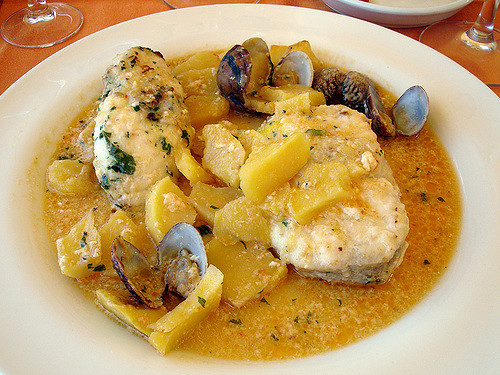Often described as a fishing town, Tossa de Mar’s main industries prior to the advent of tourism were in fact vineyards and cork.

Tossa de Mar’s culinary speciality is a fish stew called cim i tomba. Photo by Mauricio.
Despite that, Tossa is famous today for a dish originally cooked by its fishermen. That dish is now a Tossa speciality called cim i tomba and served by many Tossa de Mar restaurants. During September the town celebrates with a Cim i Tomba festival. Participating restaurants offer a starter, cim i tomba main course and dessert at a fixed price.
Today the dish has been more standardised, although it varies from chef to chef. It is usually prepared from a firm fish such as monkfish, turbot or cod. The other ingredients are onions, potatoes, tomato, garlic and olive oil, green pepper and saffron. In fact it’s similar to another Catalan fish stew known as suquet.
Cim i tomba: Tossa’s fish stew
Under the municipal charter of 1186 Tossa came under the protection of Ripoll monastery. In exchange locals were granted the right to build housing both within and outside the castle walls.
On the other hand the monastery exercised feudal rights over fishing, which is perhaps why the industry never developed as much as in other towns. They didn’t pay the tythe.
Despite this many Tossa de Mar restaurants serve a local speciality originally cooked by fishermen. The story goes something like this:
When they used to go out in their boats, the fishermen would take a number of ingredients and a stove so they could cook themselves up a stew. Any fish that was unsuitable for the market would end up stewing in the cooking pot with sliced onion, potatoes and garlic.
What I’ve read implies these fishermen went out for the day, but I think it’s more likely they were away for longer and would cook the stew when sheltering at night. Fish doesn’t last all that well though, so maybe I’m wrong.
Anyway, the town is now famous for that seafood speciality, cim i tomba.
Even if you’re not in Tossa during September you can still try the dish. It’s widely served found served year round by many of the town’s restaurants. In case you want some guidance here are some Tossa favourites. Even if you don’t fancy trying cim i tomba you should find something you like among the selection of fish and other dishes:
Castell Vell
This 1969 restaurant is inside the castle walls and serves traditional Catalan and Tossa specialities. As well as the usual – cim i tomba, paella, fideuà and fresh fish done in a variety of ways – you can find things like veal cheek in red wine sauce.
Marina
Restaurant Marina dates back to 1982 and offers three fixed price menus at €15, €18 and €28 per head. The latter includes an assortment of tapas followed by cim i tomba, suquet or prawns with rice. The price also includes wine and bread.
Sa Muralla
At the entrance to the old town, Sa Muralla was founded in the mid-twentieth century as a fisherman’s tavern. As the tourist industry started so the first tourists found their way there and evolved over the decades that followed into the restaurant it is today. Specialising in Catalan cuisine, particularly from Tossa, the menu includes paella and the rice and pasta dishes that are the staple of restaurants along the Costa Brava. As well as the obligatory cim i tomba, seafood dishes include suquet and zarzuela. Adventurous meat-lovers might like to try pig’s trotters with prawns, a Catalan speciality. The less adventurous might be relieved to see an entrecote on the menu.
Bahia
This family run restaurant is on the seafront near the castle. Established in 1954 it served authentic Catalan dishes prepared from seafood fresh from the market. In addition to Tossa’s most famous dish and paella, the Bahia serves such delicacies as cuttlefish with meatballs and gilt-head sea bream.
Ca la Carme
Also near the beach is Restaurant Ca la Carme on Carrer Enric Granados, which specialises in seasonal produce. Naturally you’ll find cim i tomba on the menu, but it’s your choice whether to go for it with monkfish, cod or rayfish. Other specilaities include squid stuffed with meatballs and a variety of different paellas.
Can Carlus
This place dates from 1974 and serves fresh fish and seafood. It’s just outside the castle walls and while it opens its doors throughout the year at weekends, it is only open during the week from April to October. One thing worth trying on the menu is dorada a la sal. It’s a simple dish. A gilt-head sea bream is completely covered in salt and baked in the oven. The salt forms a crust and is removed when served. Although if you see it you’ll probably expect it to be extremely salty that isn’t the case. The salt pulls away the skin leaving succulent unsalted flesh beneath.
Can Pini
Can Pini is another restaurant outside the castle walls. You’ll find it on Carrer del Portal, in front of clock tower. The cim i tomba served here is made with monkfish and turbot, but other specialities include local anchovies from with pa amb tomàquet, sauteed crayfish from Blanes and the ever-present paella and fideuà.

